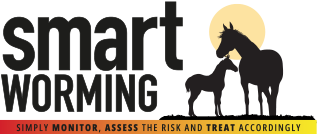There are many parasites that can infect your horse, and they can cause a wide variety of symptoms ranging from skin irritation to colic, weight loss and even death.
The descriptions below explain which worms infect the different parts of a horse’s body, and the damage they can potentially cause.
The worms which are most important to monitor for and treat if necessary, are redworms, especially small redworms, and tapeworms, plus Parascararis equorum (roundworms) in foals and youngstock. This is because of the risk of serious symptoms such as colic and severe weight loss which these worms can cause.
These worms produce eggs whilst they are living in the horse, and the eggs are shed into the environment via the horse’s droppings. The eggs develop into larvae that live on the grass, which are swallowed when the horse grazes, allowing them to develop into new adult worms inside the horse. This lifecycle means that:
- We can measure how many eggs each horse is passing into the environment
- We can reduce the risk of horses getting infected by picking up their droppings before the larvae develop and migrate onto the grass (poo-picking).
The other types of worm are less common and tend to only be treated if they are causing a problem1.









